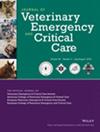Delayed Zinc Phosphide Toxicosis in a Dog
Abstract
Objective
Zinc phosphide is a widely used, commercial, non-anticoagulant rodenticide. However, there is a lack of detailed information in veterinary literature regarding its toxic effects. The purpose of this case report is to provide a comprehensive description of toxicosis caused by zinc phosphide in a dog that underwent early decontamination.
Case Summary
A 5-year-old neutered male Wolfhound mix presented 4 h after ingesting zinc phosphide. The owners had attempted decontamination by giving the dog one tablespoon of table salt orally before arrival. On initial examination, the dog showed injected mucous membranes and apparent abdominal pain. Mild hyperlactatemia (2.3 mmol/L) was documented. Initial treatment included IV administration of maropitant (1 mg/kg), esomeprazole (1 mg/kg), and compound sodium lactate (6 mL/kg/h). Fourteen hours after toxin ingestion, a generalized seizure occurred, which was controlled with diazepam (0.5 mg/kg IV). Hypoglycemia was identified and treated with a glucose bolus and continuous infusion. Metabolic acidosis was treated with sodium bicarbonate, and despite this treatment, metabolic acidosis persisted and hyperlactatemia worsened to 8.0 mmol/L. Acute hepatic failure was presumptively diagnosed based on increased prothrombin time, excessive bleeding from a lip laceration, hypoglycemia, and severely increased alanine aminotransferase activity and total bilirubin concentration. Treatment with vitamin K and N-acetylcysteine was initiated. Hypotension, which did not respond to a conservative fluid bolus, in combination with acute hepatic failure, prompted the cost-conscious owners to elect humane euthanasia.
New or Unique information Provided
This is the first report detailing a confirmed case of zinc phosphide toxidrome and acute liver failure in a dog. A retrospective study of potential exposures suggested good outcomes; however, this report demonstrates that even when signs appear limited to the gastrointestinal tract at presentation, ingestion of zinc phosphide should be aggressively monitored and treated.

 求助内容:
求助内容: 应助结果提醒方式:
应助结果提醒方式:


